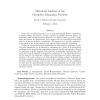Free Online Productivity Tools
i2Speak
i2Symbol
i2OCR
iTex2Img
iWeb2Print
iWeb2Shot
i2Type
iPdf2Split
iPdf2Merge
i2Bopomofo
i2Arabic
i2Style
i2Image
i2PDF
iLatex2Rtf
Sci2ools
CORR
2010
Springer
2010
Springer
Microlocal Analysis of the Geometric Separation Problem
Image data are often composed of two or more geometrically distinct constituents; in galaxy catalogs, for instance, one sees a mixture of pointlike structures (galaxy superclusters) and curvelike structures (filaments). It would be ideal to process a single image and extract two geometrically `pure' images, each one containing features from only one of the two geometric constituents. This seems to be a seriously underdetermined problem, but recent empirical work achieved highly persuasive separations. We present a theoretical analysis showing that accurate geometric separation of point and curve singularities can be achieved by minimizing the 1 norm of the representing coefficients in two geometrically complementary frames: wavelets and curvelets. Driving our analysis is a specific property of the ideal (but unachievable) representation where each content type is expanded in the frame best adapted to it. This ideal representation has the property that important coefficients are c...
| Added | 09 Dec 2010 |
| Updated | 09 Dec 2010 |
| Type | Journal |
| Year | 2010 |
| Where | CORR |
| Authors | David L. Donoho, Gitta Kutyniok |
Comments (0)

